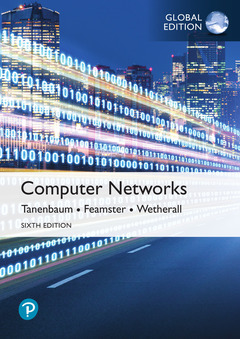Computer Networks, Global Edition (6th Ed.)
Auteurs : Tanenbaum Andrew, Feamster Nick, Wetherall David

For coursesin Business Data Communication and Networking.
Anintroduction to computer networking grounded in real-world examples
In Computer Networks,Tanenbaum et al. explain how networks work from the inside out. They start withthe physical layer of networking, computer hardware and transmission systems,then work their way up to network applications. Each chapter follows aconsistent approach: The book presents key principles, then illustrates themutilizing real-world example networks that run through the entire book ? theInternet, and wireless networks, including Wireless LANs, broadband wireless,and Bluetooth. The 6th Edition is updated throughout to reflect the mostcurrent technologies, and the chapter on network security is rewritten to focuson modern security principles and actions.
Tutorial videos on key networkingtopics and techniques are available to students on the companion website at www.pearsonglobaleditions.com
Instructors are supported with a SolutionsManual to end-of-chapter exercises featured in the book, LecturePowerPoint slides, and extracted art and figures featured in thebook.
1. Introduction
- Uses of Computer Networks
- Types of Computer Networks
- Network Technology, from Local to Global
- Examples of Networks
- Network Protocols
- Reference Models
- Standardization
- Policy, Legal, and Social Issues
- Metric Units
- Outline of the Rest of the Book
- Summary
2. The Physical Layer
- Guided Transmission Media
- Wireless Transmission
- Using the Spectrum for Transmission
- From Waveforms to Bits
- The Public Switched Telephone Network
- Cellular Networks
- Cable Networks
- Communication Satellites
- Comparing Different Access Networks
- Policy at the Physical Layer
- Summary
3. The Data Link Layer
- Data Link Layer Design Issues
- Error Detection and Correction
- Elementary Data Link Protocols
- Improving Efficiency
- Data Link Protocols in Practice
- Summary
4. The Medium Access ControlSublayer
- The Channel Allocation Problem
- Multiple Access Protocols
- Ethernet
- Wireless LANs
- Bluetooth
- DOCSIS
- Data Link Layer Switching
- Summary
5. The Network Layer
- Network Layer Design Issues
- Routing Algorithms in a Single Network
- Traffic Management at the Network Layer
- Quality of Service and Application QoE
- Internetworking
- Software Defined Networking
- The Network Layer in the Internet
- Policy at the Network layer
- Summary
6. The Transport Layer
- The Transport Service
- Elements of Transport Protocols
- Congestion Control
- The Internet Transport Protocols: UDP
- The Internet Transport Protocols: TCP, QUIC, BBR
- Performance Monitoring
- Delay-Tolerant Networking
- Summary
7. The Application Layer
- DNS — The Domain Name System
- Electronic Mail
- The World Wide Web
- HTTP/2
- Streaming Audio and Video
- Content Delivery Networks and Distributed Cloud Services
- Summary
8. Security
- Fundamentals of Network Security
- The Core Ingredients of an Attack
- Firewalls and Intrusion Detection Systems
- Cryptography
- Symmetric-Key Algorithms
- Public-Key Algorithms
- Digital Signatures
- Management of Public Keys
- Authentication Protocols
- Communication Security
- Email Security
- Web Security
- Social Issues
- Summary
9. List and Bibliography
- Suggestions for Further Reading
- Alphabetical Bibliography
Keep currentwith the most up-to-date technologies
- NEW - Coverage of modern cellular architectures includes 4G and 5G networks to reflect the most current technology.
- NEW -Ethernet and wireless networks material , specifically 40- and 100-gigabit Ethernet, 802.11.ac, 802.11ad, and 802.11ax, have been added.
- NEW - Emerging technology discussions cover topics such as virtualization and SDN.
- UPDATED - Audio and video streaming technology discussions include MPEG-DASH.
Learncomputer networks from the inside out
- The text’s unique structure and organization present learning from the base, physical layer of networks, including cable networks and satellites, to the data link layer, to the network and transportation layer, and finally to the application layer. Students will understand all aspects of networking and how the different layers affect one another.
- UPDATED - Additional readings suggested to expand students’ understanding.
Understandcurrent issues in the computer networking world
- UPDATED - Chapter 8, focusing on security, is completely overhauled to focus more effectively on network security and security incidents in practice, including security principles, fundamental attack techniques, defenses, and a wide range of systems-related security issues.
- UPDATED - Policy is now covered in several chapters.
- UPDATED - Discussion of DOCSIS a widely used access network (Internet over cable).
Date de parution : 03-2021
Ouvrage de 944 p.
21.6x29.7 cm



